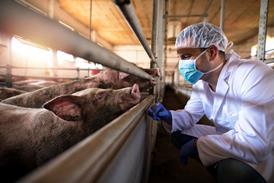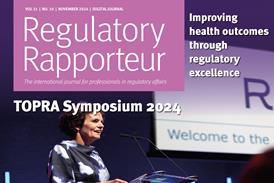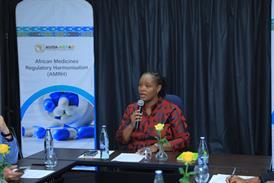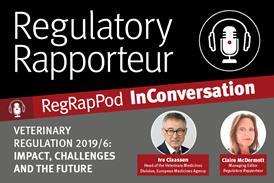The EU CTR replaced the EU CTD on 31 January 2022, which impacts investigational medicinal products that fall under genetically modified organisms (GMO-IMPs)
Licence notice
Copyright © 2015-2023 The Organisation for Professionals in Regulatory Affairs Ltd. T/A Regulatory Rapporteur − All Rights Reserved. This work is licensed to Sue Corbett for the purposes of academic and personal reasonable use only.
Notwithstanding this licence, no part of materials published in Regulatory Rapporteur may be reproduced without the express written permission of the publisher.
As a general rule, permission should be sought from the rights holder to reproduce any substantial part of a copyrighted work. This includes any text, illustrations, charts, tables, photographs, or other material from previously published sources.
To obtain permission(s) to re-use content published in Regulatory Rapporteur please email publications@topra.org.
To join TOPRA please click here.
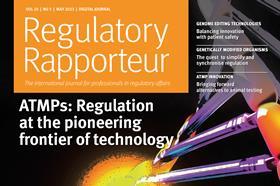
Regulatory Rapporteur
May 2023 | Volume 20 | No.5
Disclaimer:
The views expressed in this article are those of the authors
and not necessarily those of their respective companies.

The European Clinical Trials Regulation (CTR) aims to harmonise the processes for assessment and supervision of clinical trials (CT) throughout the EU. The environmental aspects of investigational medicinal products (IMPs) which fall under the definition of a genetically modified organism (GMO) are outside of the scope of the EU CTR.
As a result, GMO requirements for CT activities must still comply with the GMO regulatory framework implemented at national level. While some countries previously incorporated their national GMO processes into the CT submission processes under the EU CT Directive (2001/20/EC), this has resulted in a significant change in process, as the CTR submission portal does not provide for GMO submission components.
Recent flexibility for GMO application activities leading to the accelerated approval of COVID-19 vaccines demonstrated that it is feasible to improve study start-up times for innovative medicines. In the last couple of years, evolving GMO processes also resulted in reduced application timelines, especially for more common GMO-IMPs in several countries, as reviewed here. This underlines the need for further simplification of the regulatory processes for GMO-IMPs and a more harmonised EU process to further improve CT approval and start-up timelines and enable improved patient access to innovative products.
Introduction
Regulation (EU) No 536/2014 on clinical trials[1] (CTR) came into effect on 31 January 2022, replacing the Clinical Trials Directive 2001/20/EC[2] (CTD). Since 31 January 2023, all initial applications of interventional clinical trials (CT) for investigational medicinal products (IMPs) have to be submitted under the CTR, while ongoing trials approved under CTD may continue under current requirements until 30 January 2025.[1]
The CTR was introduced to harmonise requirements across the EU member states (MS), providing one single entry point for CT authorisation (CTA) applications via the EU Portal – Clinical Trial Information System (CTIS[3]) – as well as ensuring coordinated evaluation and supervision procedures for CT facilitating the conduct of multinational trials. The aim of the CTR is ultimately to increase the number of CT being conducted in the EU. This is further supported by a joint European Commission (EC), European Medicines Agency (EMA) and Heads of Medicines Agencies (HMA) initiative[4] launched in January 2022 to facilitate innovation in CT, stakeholder engagement and regulatory network collaboration to transform CT in Europe.
The environmental aspects of IMPs containing or consisting of genetically modified organisms – GMOs; hereafter referred to as GMO-IMPs – such as many advanced therapy medicinal products (ATMPs) and viral-vector-based vaccines, are outside of the scope of the CTR (Article 91), meaning that GMO applications have to remain under national procedures – and CTIS cannot be used. GMO-IMPs still need to comply with the GMO legislative framework, namely the Directives for Contained Use (CU) (Directive 2009/41/EC[5]) or Deliberate Release (DR) (Directive 2001/18/EC[6]) and their national transpositions.
This has led to significant differences across EU MS, including the framework the GMO-IMP CT falls under – CU and/or DR – the documentation and submission requirements, application procedures (whether site or sponsor is the applicant) and timelines[7], (GMO application timelines are determined independently of CTA legislation). The absence of provisions to optimise GMO applications has been highlighted by many stakeholders including EMA, national competent authorities and sponsors.[8],[9],[10]
This article discusses the impact of the CTR on GMO application processes for accurate planning of CTIS and national submissions. A few specificities of the new CTR process for GMO-IMP trials are highlighted and an update is provided on the GMO application processes considering recent initiatives to streamline the GMO-IMP assessment at the EC and country level.
CTR CTA process overview
The CTA process under the CTR follows mechanisms similar to the CTD: validation, assessment, requests for information (RFI) from competent authorities and ethics committees, and their answers and decision, but with some nuances:
- Application dossier: The dossier is in two parts, one for the core scientific information (Part I) and one for country-specific documents and information (Part II, one submission package per country). Part I is assessed collectively by all Concerned MS under the coordination of a Reporting MS (RMS), meaning one round of RFIs for the whole Part I – and a common Part I assessment report – while Part II is assessed at the country level by each MS.
- Submission process: All submissions are made via the CTIS portal for the whole trial. This places more weight on the timely availability of country-specific information, documents and translations to complete the CTA dossier and perform the trial submission. See Figure 1 and Table 1 for submission scenarios under CTR and their corresponding timelines.
- Review times: Timelines for assessment are specified in the CTR with timeline extensions in case of RFIs or if the IMP is an ATMP or another innovative therapy – as defined in CTR[1] Articles 6 & 7. The trial decision remains a MS prerogative which integrates both Part I and Part II assessment outcomes.
- Transparency: All interactions during the assessment and later procedures during the conduct of the trial have to be completed via CTIS. All information posted in CTIS falls under the disclosure rules of the CTR and will be made public at some point, if not considered commercially confidential information (CCI) or protected personal data (PPD). This increased transparency mandates increased caution in the management of CCI and PPD information at each step of the process – initial application, answer to RFIs, later modifications and notifications.
Interplay between CTR CTA and GMO process
As stated earlier, Article 91 of the CTR1 specifically excludes several other EU Directives from its scope: GMOs – both CU and DR Directives – ionising radiations, blood, tissues and cells. Other regulations also need to be factored in when planning CT, such as the Medical Device Regulation,[11] the In Vitro Diagnostic Medical Device Regulation, [12] and the General Data Protection Regulation.[13] CTIS, at the current time, cannot be used by MS to process specific additional applications for these products which may be mandated at a country level. Managing the interplay of all applicable regulations adds an extra layer of complexity.
For GMO-IMPs, a separate application to the GMO competent authority is still required in many countries, independently of the clinical trial framework – CTD or CTR.[14],[15] Several countries in the EU – Estonia, Germany, Greece, Lithuania and Sweden – previously adapted their process, embedding the GMO review in their CTA application with a single submission procedure. As a result, those MS have had to re-adapt their processes under the CTR in order to separate the CTA and GMO application into two distinct procedures, the CTA via CTIS and the GMO application on national level (examples in Table 2).
For GMO-IMPs, a separate application to the GMO competent authority is still required in many countries, independently of the clinical trial framework – CTD or CTR
For countries which required the GMO application to take place prior to the CTA submission – Bulgaria, Poland, Romania, Slovenia and Slovakia – this prior authorisation under the GMO framework can no longer be a pre-requisite for a valid CTA application. Under the CTR, a CTA application cannot be turned down on grounds that the authorisation under the GMO framework has not been obtained when the CTA application is submitted.[16] However, some countries may still have interdependencies – eg., site GMO approval to be included in Part II dossier in CTIS.
In summary, despite the GMO legislation being excluded from the scope of the CTR, CTA and GMO applications are not completely independent in certain countries (Figure 2) and interdependencies will need to be further assessed based on actual experience in the coming months.
Although maximum review timelines are stated for CTAs in the CTD and CTR legislation, this is still not the case for GMOs. However, considering the CTR timelines – and the 50 days assessment timeline extension for innovative therapies (Table 1) – it is expected that GMO timelines, at least in countries allowing for a fully parallel process between CTIS CTA application and GMO national procedures, do not significantly impact activation timelines when considering assessment duration and other country- and site-activation procedures.
Evolving GMO requirements
GMO-IMPs cover a wide range of products including ATMPs and viral vector-based vaccines. The GMO application process has evolved in recent years following the development of the common application forms (CAFs) available[17] for several well-established product type[18],[19],[20] (Figure 3). Product-specific CAFs, which can be used to support applications under both CU and DR, are now more widely accepted across MS – as specified on the front page of each CAF. Of note, DR applications with the CAF also require a Summary Notification Information Format[21] (SNIF).
Since 2 October 2022, the SNIF has to be uploaded to the E-Submission Food Chain (ESFC) Platform[22], and applications under DR require proof of submission to this platform.
In conjunction with the CAF, applicants may refer to Environmental Risk Assessments (ERAs) published in the Good Practice documents[23],[24] for genetically modified human cells (GMCs) and adeno-associated viral vectors (AAVs) instead of preparing a product-specific ERA, if the product falls within set parameters (Figure 3).
The growing acceptability of the CAFs and specific ERAs enables more efficient preparation of core GMO dossiers for well-established GMO product types. These documents can also be used to support marketing authorisation applications (MAAs) as represented by EMA procedural advice.[25] However, not all EU countries accept all three CAFs. Some accept them but require additional information as indicated in the CAFs – eg., site maps. Furthermore, some countries also expect additional documents as part of the GMO application.
In countries which do not accept the CAFs and specific ERAs, or for other novel GMO product types not covered by the CAFs (eg., genetically modified bacteria), technical dossier and risk assessment documentation which is not specific for medicines has to be used[14],[15] – as specified in the Annexes of the respective CU and DR Directives.[5],[6]
The growing acceptability of the CAFs and specific ERAs enables more efficient preparation of core GMO dossiers for well-established GMO product types
Some countries are taking a more pragmatic approach to well-established products for which a CAF and/or specific ERA is available. For example, the Netherlands have shortened review timelines for products which fall under the specific ERAs (Figure 3) or copy applications (Table 2).[26],[27],[28],[29] The Netherlands also offer the option for sites to submit a platform application for specific product types – eg., AAVs or GMCs – which cover all trials with the same product even for different sponsors. Similarly, France streamlined the submission process for CT with GMO-IMPs in 2022 (Table 2).
Strategic considerations to navigate clinical trials with GMO-IMPs
Navigating the evolving regulatory landscape in Europe to develop GMO-IMPs will remain challenging for the foreseeable future. It is essential to invest time, early on in strategic planning activities, to generate robust but flexible regulatory submissions plans considering the following critical points:
Data-driven approach: Understanding the product characteristics – eg., parent and donor organisms, cloning vectors, replication-competency – and the planned use of the GMO – eg., administration route, biodistribution and shedding profile, containment measures – to enable the determination of the product-specific risks and selection of the most suitable classification (biosafety[30] and containment level[5]) or route of application (CU and/or DR) for each country based on local requirements.
GMO dossier compilation: It is important to consider the potential target countries and product characteristics/risks to develop a concise but articulate GMO application dossier that can serve for multiple applications and be easily adapted – eg., whether the CAF is applicable and all potential countries endorse its use. The appropriate information – eg., how the GMO was derived from the parental organism – and supporting data – eg., molecular characterisation, biodistribution and shedding data, analytical methods – need to be collected alongside the early development and manufacturing of the GMO-IMP to prepare the GMO dossier required for CTA and licensing applications. To avoid the need to make updates to the application on an ongoing basis, it is recommended to ensure only that information which is essential for the discussion of the biosafety/environmental risks is included in the application.
GMO feasibility and local requirements: Once the product reaches the clinical phase, it is recommended to understand the country-specific GMO application processes and timelines in addition to including GMO feasibility in the country/site selection process, as they both impact the overall study start-up timelines. Site considerations include GMO-readiness (if established GMO procedures in place) and experience, especially in countries where the sites submit the application. Early identification of suitable clinical sites and the development of good working relationships is vital. Some countries also have specific product-handling and storage-location requirements – eg., safety cabinet and/or closed systems requirements – or require a site-specific GMO permit in addition to the trial-specific application.
Build pan-EU strategy: Devising a submission strategy for CTA applications under the CTR can be challenging, taking into consideration the different requirements, application procedures and timelines for GMOs at the national level and the remaining interdependencies with the CTA process using CTIS. Most countries have now evolved to accept the GMO and CTA applications in parallel. Mitigation strategies are required in case of country-specific delays or where interdependencies between GMO and CTA applications exist – see section on interplay – (Figure 2). Based on the countries selected, consideration is required on which of the submission approaches (Figure 1) is feasible and most favourable to minimise time to country decision. In countries with a parallel process, improved overlap of GMO and CTA assessment and contract negotiations timelines could mean that GMO application are now less likely to be rate-limiting to country activation.
COVID-19 vaccine GMO derogation
As the COVID-19 pandemic was declared a public health emergency, the EC established Regulation (EU) 2020/1043[31] providing a derogation for COVID-19 CT of GMO-IMPs, effective 17 July 2020. With this derogation, the EC acknowledged the challenges for GMO-IMPs for multi-country clinical studies.[32] Unfortunately, this effective date was too late for several early COVID-19 vaccine CT. Moreover, prior to the effective date, the Netherlands already shortened their procedure to just two weeks and some other countries agreed to a derogation or streamlined process – local forms /SNIF could still be required. For consecutive trials however, the derogation allowed for reduction of timelines in study start-up as it reduced the resources needed for preparing the submissions and, as the GMO application was not required, allowed a faster study setup.
The GMO derogation for COVID-19 vaccines led to discussions in trade associations, resulting in an EFPIA white paper[8] acknowledging how stakeholders “consider that the GMO legislation is not specifically designed for medicinal products and hinders the conduct of clinical trial s.” More specifically, its position is that there are “no environmental and biosafety risks for non-replicating viral vectors or GM human cells, as these do not duplicate and cannot survive in the environment”.
Conclusion
The CTR was introduced to harmonise requirements across EU MS and increase the number of CT being performed in the EU. Although the CTR is in its infancy, information on its impact on GMO processes available at this early stage highlights that managing the interplay between the CTA and GMO legislations provides an extra layer of complexity for CTA applications for innovative products.
Recent initiatives to simplify the GMO assessments, such as adapting the dossier requirements for well-established low-risk GMO-IMPs and several MS updating their GMO application processes, are encouraging steps forward in streamlining the process where GMO procedures might no longer be a rate-limiting step in the countries which have implemented changes.
The EC has acknowledged[31],[33] that the current regulatory requirements for the authorisation of GMOs are not fit for purpose and that they should address the specificities of medicines, and the conduct of CT with those products in the EU (which is currently hindered by the fragmentation of national requirements). Solutions are currently being evaluated as part of the Pharmaceutical Strategy for Europe[33] and are expected to be published in the first half of 2023.
Acknowledging that a large number of GMO-IMPs are being developed to address unmet medical needs in rare diseases, oncology or as vaccines for infectious diseases, simplification of the regulatory processes for GMO-IMPs would be beneficial. Equally, a more pragmatic, risk-based approach which introduces regulatory flexibility for managing GMO-IMPs, such as derogations for low-risk products (as tried and tested for GMO-based COVID-19 vaccines), and a more harmonised EU process would be advantageous. Simplifying the application process required to initiate CT with innovative IMPs in Europe would encourage developers to return to Europe, especially if CT start-up timelines are competitive. This would ultimately enable patient access to innovative products in a timely manner.
May 2023 | Volume 20 | No.5
- Mind the gap: Innovation vs regulation of ATMPs
- G-E-T-ting there – how gene editing technologies could change more than genes
- Alternatives to animal testing in the development of ATMPs
- Evolution of GMO requirements for innovative investigational medicinal products upon transition to the EU CTR
- Ensuring promotional materials’ compliance in the EU
- Regulatory guidelines for nutraceuticals in India
References:
[1] Regulation (EC) No 536/2014 on clinical trials on medicinal products for human use. (Accessed 19 January 2023).
[2] Directive 2001/20/EC on the approximation of the laws, regulations and administrative provisions of the Member States relating to the implementation of good clinical practice in the conduct of clinical trials on medicinal products for human use. (Accessed 19 January 2023).
[3] CTIS landing page. (Accessed 19 January 2023).
[4] European Medicines Agency. (2022) Accelerating Clinical Trials in the EU (ACT EU). (Accessed 16 January 2023).
[5] Directive 2009/41/EC on the contained use of genetically modified micro-organisms. Official Journal of the European Union. 2009. (Accessed 19 January 2023).
[6] Directive 2001/18/EC on the deliberate release into the environment of genetically modified organisms. (Accessed 3 February 2023).
[7] Whomsley, R., Palmi Reig, V., & Hidalgo-Simon, A. (2021). Environmental risk assessment of advanced therapies containing genetically modified organisms in the EU. British journal of clinical pharmacology, 87 (6), 2450–2458.
[8] Lambot N, Awigena-Cook J, Reimer T, et al. (2021) Clinical trials with investigational medicinal products consisting of or containing genetically modified organisms: implementation of Clinical Trials Regulation EU 536/2014, Cell & Gene Therapy Insights 7(9), 1093-1106.
[9] Efpia.eu. (2021) EFPIA calls for a Greater Harmonisation of Genetically Modified Organism (GMO) Procedures for Investigative Medicinal Products. (Accessed 12 January 2023).
[10] Beattie, S., & Alliance for Regenerative Medicine (ARM), European Federation of Pharmaceutical Industries and Associations (EFPIA), European Association for Bioindustries (EuropaBio) (2021). Call for More Effective Regulation of Clinical Trials with Advanced Therapy Medicinal Products Consisting of or Containing Genetically Modified Organisms in the European Union. Human gene therapy, 32 (19-20), 997–1003.
[11] Regulation (EU) 2017/754 on medical devices. (Accessed 3 February 2023).
[12] Regulation (EU) 2017/746 on in vitro diagnostic medical devices. (Accessed 3 February 2023).
[13] Regulation (EU) 2016/679 on the protection of natural persons with regard to the processing of personal data and on the free movement of such data (General Data Protection Regulation) (Accessed 3 February 2023).
[14] Westra de Vlieger J, McConnell C, Bhatti S et al. (2019) Navigating European GMO requirements for investigational medicinal products. Regulatory Rapporteur. 16(4):23–29. (Accessed 27 January 2023).
[15] Delahaye EG, Liberman J, Michel M. (2020) Clinical trials with GMOs in the EU – from regulatory to sites. Regulatory Rapporteur. 17(6):4-9. (Accessed 27 January 2023).
[16] European Commission. (2019) Advanced Therapies. Medicinal products for human use containing or consisting of GMOs: Interplay between the EU legislation on medicinal products and GMOs, Frequently Asked Questions, Version 3. (Accessed 19 January 2023).
[17] European Commission. Advanced Therapies. (Accessed 27 January 2023).
[18] European Commission. (2022) Advanced Therapies. Common application form for investigational medicinal products for human use that contain or consist of AAV vectors. Version 3. (Accessed 27 January 2023).
[19] European Commission. (2022) Advanced Therapies. Common application form for viral vectors contained in investigational medicinal products for human use. Version 3. (Accessed 27 January 2023).
[20] European Commission (2021) Advanced Therapies. Common Application form for clinical research with human cells genetically modified. Version 5. (Accessed 27 January 2023).
[21] Pursuant to article 11 of Directive 2001/18/EC and published on the Council Decision 2002/813/EC. (Accessed 3 February 2023).
[22] E-Submission Food Chain Platform (ESFC) webpage. (Accessed 27 January 2023).
[23] European Commission. (2022) Advanced Therapies. Good Practice on the assessment of GMO related aspects in the context of clinical trials with AAV clinical vectors. Version 3. (Accessed 27 January 2023).
[24] European Commission. (2021) Advanced Therapies. Good Practice on the assessment of GMO-related aspects in the context of clinical trials with human cells genetically modified. Version 5. (Accessed 27 January 2023).
[25] EMA guidance EMA/821278/2015. European Medicines Agency pre-authorisation procedural advice for users of the centralised procedure (revision of 21 December 2022). (Accessed 27 January 2023).
[26] ANSM. Declaration/Autorisation d’utilisation confinée ou de dissémination volontaire des médicaments contenant ou composés d’organismes génétiquement modifies. (Accessed 3 February 2023).
[27] Paul-Ehrlich-Institut. Clinical trials with GMOs. Form requesting additional information on activities with the GMO in the framework of the requested clinical trial. (Accessed 27 January 2023).
[28] Gene Therapy Desk. IenW procedure vergunning onder vaste voorwaarden vovIen (VoV). (Accessed 3 February 2023).
[29] Swedish MPA. Medicinal products containing GMO. (Accessed 3 February 2023).
[30] Directive 2000/54/EC of the European Parliament and of the Council of 18 September 2000 on the protection of workers from risks related to exposure to biological agents at work. (Accessed 27 January 2023)
[31] Regulation (EU) 2020/1043 on the conduct of clinical trials with and supply of medicinal products for human use containing or consisting of genetically modified organisms intended to treat or prevent coronavirus disease (COVID-19). (Accessed 27 January 2023).
[32] McGoldrick M, Gastineau T, Wilkinson D, et al. How to accelerate the supply of vaccines to all populations worldwide? Part II: Initial industry lessons learned and detailed technical reflections leveraging the COVID-19 situation. Vaccine. 2022 Feb 23;40(9):1223-1230.
[33] European Commission (2020). Pharmaceutical Strategy for Europe. (Accessed 27 January 2023)








